Operators should think long term when purchasing high-tech displays.
For foodservice operators, “pay now or pay later” might be the advice for buying anything from kitchenware to appliances. By paying more for a higher quality product up front, the business can avoid having to replace or repair the item later — and save money in the long run. That includes purchasing cutting-edge technology such as digital signage. While it may be tempting to buy a no-frills screen at a low price, operators should consider the total cost of ownership, or how much the business will spend over the lifetime of the display system. To calculate the total cost of ownership, the operator must weigh several factors, such as reliability, warranty, labor costs and future-proofing. Not all display monitors and media players are created equal, and a higher quality system could prove to be less costly in the long run.
1. Reliability
Buying a digital signage solution is similar to buying other technology. “When you begin the research and evaluation process, you are considering not only your current requirements, but also long-term technology goals.” says Jason Shelton, national account manager, vertical sales-QSR/retail for Itasca, Ill.-based NEC Display Solutions of America, Inc. “I design a Digital
Signage Solution with the same intent. I specify the hardware and software products to match the performance and functionality that the customer wants to achieve,” he added.
The most essential requirement is that the screens and media player always work. From front-of-the-house menu boards to back-of-the-house systems which display orders for kitchen staff, the digital signage must withstand heat, dust, grease and being on for hours each day. For that reason, Shelton recommends that operators buy commercial-grade display solutions, which are generally more expensive than a consumer-quality screen that one can buy at a big box store. The higher price is worth it in the long run. Consumer-grade products are not designed or warrantied to support the daily run-time requirements of commercial use.
NEC is a leading designer and provider of such equipment as:
- Commercial- and professional-grade, large-screen LCD displays.
- Desktop LCD monitors.
- Direct view LED displays.
- Multimedia and installation projectors.
- Integrated display solutions.
2. Warranty
Most digital signage companies offer a three-year warranty, but last year NEC announced it will offer a five-year warranty for four of its P series signage display models. In a press release, product manager Ben Hardy notes that the “robust design and build of these models gives us the confidence to offer this five-year warranty.”
The warranty covers:
- Parts and labor specific to warranty failure.
- Ground shipping cost to return to NEC.
- Second-day shipping cost to customer.
Digital signage involves more than just screens. Frequently, systems also require a media player, which needs to always work. NEC’s new P series and V series displays have multiple features which help operators to keep their screens on, including an Open Pluggable Specification (OPS) Slot for various high-performance PCs, a Raspberry Pi module, and an integrated media player. With these displays having multiple media player options, it makes it a great solution for media player redundancies, where having a backup solution helps to reduce your potential fail rate and downtime.
 3. Labor costs
3. Labor costs
“Companies can appreciate the value of that minimized downtime. With the displays being the product with the lowest fail rate, redundant media player options provide a more reliable solution.” Shelton says.
4. Future-proof
If the restaurant plans to change menu items or add animation or other innovative content, it makes sense to buy a content management system which performs these tasks reliably, and easily. If the system is cloud-based, the operator can update menu items and other information with a few taps on a smartphone.
Operators also must consider screen size, especially if they plan to expand the location’s square footage. Customers must be able to see the menu boards from a distance. In foodservice, LED backlit display screens usually measure 48 or 55 inches, with other sizes available too.
Finally, the cost of electricity has to be factored into the total cost of ownership, so it helps to have a digital display system which is energy efficient.
Every operator must weigh cost versus future benefits when selecting a digital display system. It is important to consider not only upfront capital, but the long-term recurring costs, to calculate the total cost of ownership.

